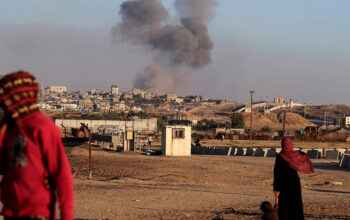
Canada’s capacity to prevent wildfires has been shrinking for decades because of budget cuts, a loss of some of the country’s forest service staff, and onerous rules for fire prevention, turning some of its forests into a tinderbox.
As residents braced for what could be the worst wildfire season on record, and one that is far from over, the air slowly cleared over the Northeastern United States on Friday, but hundreds of wildfires continued to burn across Canada.
Thanks to some rain and cloud cover near wildfire areas, with scattered rains expected in parts of southern Ontario on Sunday, Steven Flisfeder, a warning preparedness meteorologist at Environment and Climate Change Canada, predicted that the weekend could bring better air quality in Toronto, the country’s largest city.
“That’s going to help flush out the contaminants from the air a little bit,” he said.
More than 1,100 firefighters from around the world have been dispatched across Canada to help combat the country’s raging fire season, officials said, including groups from France, Chile, Costa Rica, the United States, Australia, New Zealand and South Africa.
Wildfire emergency response management is handled by each of the 10 provinces and three territories in Canada, but hundreds of blazes across the country have stretched local resources thin, and renewed calls for a national firefighting service.
At a time when many Canadians are asking if the country has enough wildfire fighting resources, several experts say the government should be focused on doing all it can to prevent wildfires, a focus from which it has strayed since budget cuts imposed in the 1990s that hampered the nation’s forest service.
“We need to do more to get ahead of the problem,” said Mike Flannigan, who studies wildfires at Thompson Rivers University in Kamloops, British Columbia, a community in the heart of that province’s wildfire country. “And progress on that has been slow, primarily because we are kind of stuck in this paradigm that fire suppression is the solution.”
People who study Canada’s response say it’s been weakened by a variety of forces, including local and national budget cuts for forests, cumbersome safeguards for fire prevention and a steep reduction in the number of forest service employees.
British Columbia spent 801 million Canadian dollars (about $601 million) on fighting forest fires during the unusually hot year 2021 wildfire season, which saw fire wipe out the town of Lytton. But the province’s current wildfire prevention budget is just 32 million dollars a year.
Similar disparities exist in other provinces, which tend to invest in small, community-based programs that protect villages and towns rather than mitigating the risk of fire throughout forests, increasing the threat of out-of-control wildfires.
The small programs are helpful, involving measures like clearing forest floors on the periphery of towns and creating fire breaks between settlements and forests. But to reduce runaway wildfires, broader measures are necessary, experts said.
One of the fire prevention methods that Canada should expand, experts said, is prescribed burns, a practice that involves setting a specific area on fire under controlled conditions to incinerate trees, dead branches, brush and other materials that could otherwise be fuel for wildfires.
It also stimulates ecological restoration, clearing the canopy cover to allow sunlight to reach the forest floor and promote new growth, as well as opening the cones of some tree species to free seeds.
“It’s a great technique, but we haven’t used it that much in Canada,” said Daniel Perrakis, a fire scientist at the Canadian Forest Service. “With climate change, we’re clearly seeing different fire behavior.”
Some communities of Indigenous people — whom wildfires disproportionately affect because they often live in fire-prone areas — have hewed to the practice of controlled burning.
Two years ago, while a record-breaking heat wave exacerbated wildfires across British Columbia, some of the flames roared close to the Westbank First Nation, an Indigenous community in the Okanagan Valley. But years of thinning the forest and managing their land using cultural burning practices prevented the fire from causing any major damage to the community.
Across Canada, there are a handful of controlled burns each year, according to partial figures compiled by the National Forestry Database. Foresters seeking to perform them must go through a lengthy process to get approval from a province.
The burns are generally unpopular in places like public parks, and even more so when they go wrong. In 1995, more than 1,000 people were evacuated after a prescribed burn got out of control and threatened the town of Dubreuilville, Ontario.
In some fire seasons, the duration of the approval process exceeds the narrow window when weather conditions are favorable for controlled burns.
The rules minimize the risk of an out-of-control prescribed burn, but they increase the risk of an out-of-control wildfire.
“Essentially, you’ve handcuffed folks — foresters and silviculturists — from being able to get off successful prescribed burns because we made the rules so onerous and so restrictive” causing more wildfire fuel to be left on the forest floor, said Sarah Bros, a forester and co-owner at Merin Forest Management based in North Bay, Ontario, who has done prescribed burning. “Harvesting doesn’t do what Mother Nature does.”
Budget cuts in the late 1990s, called for by the prime minister at the time, Paul Martin — known as a “deficit slayer” — left few government agencies untouched, shrinking the Canadian Forest Service’s staff size from 2,200 to the 700 people it now employs.
“There was an incredible brain drain,” said Edward Struzik, a fellow at the Institute for Energy and Environmental Policy at Queen’s University in Ontario and author of the book “Dark Days at Noon: The Future of Fire.”
“People were mortified, and continue to be mortified, by the fact that we have this situation that’s unfolding, this new fire paradigm, and the forest service’s just getting chump change to address it,” he said.
Dan Bilefsky contributed reporting from Montreal. Remy Tumin contributed reporting from New York.



